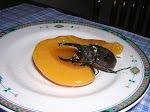My aquatic entomology course went collecting in local rivers and streams most Saturdays in January. Here are a few of the more neat looking aquatic insects I've sorted from my samples so far:
 Center three insects: Mayflies (order Ephemeroptera).
Center three insects: Mayflies (order Ephemeroptera).A pretty pink Heptageniid at 11 O'clock, and two Ephemerellids.
This is how you capture them using: a D-net (so named, I think, because it's shaped like a "D"). The straight part of the net's frame (i.e., the stem of the "D") lays flush against the stream bed. By kicking the substrate (gently!) upstream of the net, insects become dislodged and the current carries them into your net. Like this:
Next: you empty the contents of your net into a bucket or bowl with water. This is where it gets fun, where the crazed look of gambling and greed not uncommon in casinos begins to take over... You never know what each sample will turn up. You can hope, and even guess based on the river or stream and where at within-stream you sample from. But you never know for sure what kind of cool critter will go swimming past your forceps...and there are always surprises! Adventure in a bucket.
 The aquatic entomology class, OSU '09.
The aquatic entomology class, OSU '09. To snap us out of sampling, our instructor bribed us with donuts back at the van.
Impact to streams is neglible (we were assured); one insect may lay hundreds of eggs, and there seem to be innumerable insects in healthy streams...
The purpose of all this crazed gambl -- er, colleting? The simple answer: it's 40% of our course grade (along with the proper identification of the insects for our collection). In the real world beyond grad school, aquatic insects can help piece together information about what's going on in a particular river or stream or watershed. What is found (diversity), how many of them are found (abundance), and what life stage they're in (development, growth) is actually pretty useful for making determinations that guide fisheries managers, watershed projects, city planners, and of course a variety of conservation efforts. Learning about aquatic entomology and its usefulness as a tool in this way is why I am in grad school.
And this was my Friday night:
....No complaints from me. I wouldn't have it any other way.


+reduced.jpg)


No comments:
Post a Comment